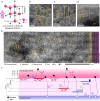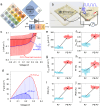Transparent integrated pyroelectric-photovoltaic structure for photo-thermo hybrid power generation
- PMID: 38658539
- PMCID: PMC11519937
- DOI: 10.1038/s41467-024-47483-2
Transparent integrated pyroelectric-photovoltaic structure for photo-thermo hybrid power generation
Abstract
Thermal losses in photoelectric devices limit their energy conversion efficiency, and cyclic input of energy coupled with pyroelectricity can overcome this limit. Here, incorporating a pyroelectric absorber into a photovoltaic heterostructure device enables efficient electricity generation by leveraging spontaneous polarization based on pulsed light-induced thermal changes. The proposed pyroelectric-photovoltaic device outperforms traditional photovoltaic devices by 2.5 times due to the long-range electric field that occurs under pulse illumination. Optimization of parameters such as pulse frequency, scan speed, and illumination wavelength enhances power harvesting, as demonstrated by a power conversion efficiency of 11.9% and an incident-photon-to-current conversion efficiency of 200% under optimized conditions. This breakthrough enables reconfigurable electrostatic devices and presents an opportunity to accelerate technology that surpasses conventional limits in energy generation.
© 2024. The Author(s).
Conflict of interest statement
The authors declare no competing interests.
Figures





Similar articles
-
Enhancement of a pyroelectric body energy harvesting scheme employing pulsed electric fields.Rev Sci Instrum. 2023 Jul 1;94(7):075005. doi: 10.1063/5.0156854. Rev Sci Instrum. 2023. PMID: 37466409
-
Photothermally Activated Pyroelectric Polymer Films for Harvesting of Solar Heat with a Hybrid Energy Cell Structure.ACS Nano. 2015 Dec 22;9(12):11830-9. doi: 10.1021/acsnano.5b04042. Epub 2015 Nov 2. ACS Nano. 2015. PMID: 26308669
-
Photovoltaic-Pyroelectric Coupled Effect Induced Electricity for Self-Powered Photodetector System.Adv Mater. 2017 Dec;29(46). doi: 10.1002/adma.201703694. Epub 2017 Oct 23. Adv Mater. 2017. PMID: 29058793
-
Energy Harvesting Research: The Road from Single Source to Multisource.Adv Mater. 2018 Jun 7:e1707271. doi: 10.1002/adma.201707271. Online ahead of print. Adv Mater. 2018. PMID: 29877037 Review.
-
Pyro-Phototronic Effect for Advanced Photodetectors and Novel Light Energy Harvesting.Nanomaterials (Basel). 2023 Apr 11;13(8):1336. doi: 10.3390/nano13081336. Nanomaterials (Basel). 2023. PMID: 37110922 Free PMC article. Review.
Cited by
-
Design strategies for energy-harvesting photovoltaics in diverse environments.iScience. 2025 Aug 6;28(9):113312. doi: 10.1016/j.isci.2025.113312. eCollection 2025 Sep 19. iScience. 2025. PMID: 40927677 Free PMC article.
-
Quantifying the pyroelectric and photovoltaic coupling series of ferroelectric films.Nat Commun. 2025 Jan 18;16(1):828. doi: 10.1038/s41467-025-56233-x. Nat Commun. 2025. PMID: 39827231 Free PMC article.
References
-
- Pan, C., Zhai, J. & Wang, Z. L. Piezotronics and piezo-phototronics of third generation semiconductor nanowires. Chem. Rev.119, 9303–9359 (2019). - PubMed
-
- Velarde, G., Pandya, S., Karthik, J., Pesquera, D. & Martin, L. W. Pyroelectric thin films—Past, present, and future. APL Mater.9, 010702 (2021).
-
- Pandya, S. et al. Pyroelectric energy conversion with large energy and power density in relaxor ferroelectric thin films. Nat. Mater.17, 432–438 (2018). - PubMed
-
- Ok, K. M., Chi, E. O. & Halasyamani, P. S. Bulk characterization methods for non-centrosymmetric materials: Second-harmonic generation, piezoelectricity, pyroelectricity, and ferroelectricity. Chem. Soc. Rev.35, 710–717 (2006). - PubMed
LinkOut - more resources
Full Text Sources

